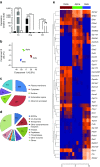Transcriptomic profiling of pancreatic alpha, beta and delta cell populations identifies delta cells as a principal target for ghrelin in mouse islets
- PMID: 27390011
- PMCID: PMC5016554
- DOI: 10.1007/s00125-016-4033-1
Transcriptomic profiling of pancreatic alpha, beta and delta cell populations identifies delta cells as a principal target for ghrelin in mouse islets
Abstract
Aims/hypothesis: Intra-islet and gut-islet crosstalk are critical in orchestrating basal and postprandial metabolism. The aim of this study was to identify regulatory proteins and receptors underlying somatostatin secretion though the use of transcriptomic comparison of purified murine alpha, beta and delta cells.
Methods: Sst-Cre mice crossed with fluorescent reporters were used to identify delta cells, while Glu-Venus (with Venus reported under the control of the Glu [also known as Gcg] promoter) mice were used to identify alpha and beta cells. Alpha, beta and delta cells were purified using flow cytometry and analysed by RNA sequencing. The role of the ghrelin receptor was validated by imaging delta cell calcium concentrations using islets with delta cell restricted expression of the calcium reporter GCaMP3, and in perfused mouse pancreases.
Results: A database was constructed of all genes expressed in alpha, beta and delta cells. The gene encoding the ghrelin receptor, Ghsr, was highlighted as being highly expressed and enriched in delta cells. Activation of the ghrelin receptor raised cytosolic calcium levels in primary pancreatic delta cells and enhanced somatostatin secretion in perfused pancreases, correlating with a decrease in insulin and glucagon release. The inhibition of insulin secretion by ghrelin was prevented by somatostatin receptor antagonism.
Conclusions/interpretation: Our transcriptomic database of genes expressed in the principal islet cell populations will facilitate rational drug design to target specific islet cell types. The present study indicates that ghrelin acts specifically on delta cells within pancreatic islets to elicit somatostatin secretion, which in turn inhibits insulin and glucagon release. This highlights a potential role for ghrelin in the control of glucose metabolism.
Keywords: Alpha cells; Beta cells; Delta cells; Ghrelin; Glucagon; Insulin; RNA sequencing; Somatostatin.
Conflict of interest statement
Funding This work was supported by the European Foundation for the Study of Diabetes and Boehringer Ingelheim Basic Research Programme; the Wellcome Trust (grants 106262/Z/14/Z, 106263/Z/14/Z and 100574/Z/12/Z); the Medical Research Council Metabolic Diseases Unit (grants MRC_MC_UU_12012/3 and MRC_MC_UU_12012/5); and the Novo Nordisk Foundation. Duality of interest statement The authors declare that there is no duality of interest associated with this manuscript. Access to research materials All transgenic animal models used can be requested from the corresponding authors subject to material transfer agreement negotiation. The RNA-sequencing data have been deposited at NCBI Gene Expression Omnibus AccNo: GSE76017. Contribution statement AEA designed and performed experiments, prepared figures and wrote the manuscript. BS designed and performed experiments, helped to prepare figures and revised the manuscript. BYHL performed analysis, helped to prepare figures and revised the manuscript. GSHY and JJH contributed to the design and analysis of experiments and revised the manuscript. FR and FMG conceived and designed the project, analysed the data and revised the manuscript. All authors approved the final manuscript. FMG and FR are jointly responsible for the integrity of the work as a whole.
Figures




References
Publication types
MeSH terms
Substances
Grants and funding
LinkOut - more resources
Full Text Sources
Other Literature Sources
Molecular Biology Databases

